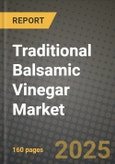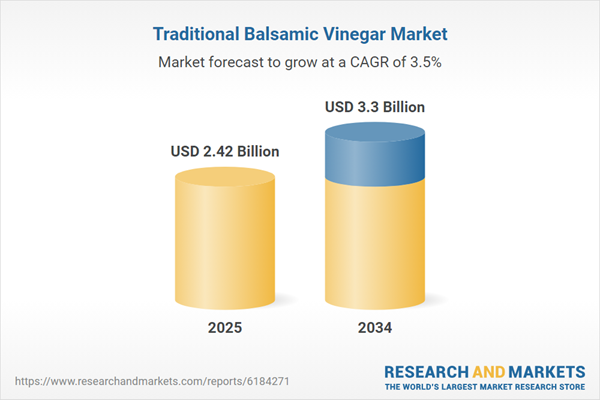Traditional Balsamic Vinegar Market
Traditional balsamic vinegar (TBV) refers to strictly regulated, slow-aged vinegars produced from cooked grape must and matured for years in successively smaller wooden barrels - an artisanal process safeguarded by geographic indications and producer consortia. Positioned as a premium finishing condiment, TBV commands distinct usage versus mass-market balsamic: a few drops applied to elevate cheeses, cured meats, grilled vegetables, steaks, risotti, strawberries, gelato, and fine pastry. Demand is anchored in gourmet retail, specialty e-commerce, high-end foodservice, corporate gifting, and culinary tourism. Current trends emphasize provenance storytelling, chef collaborations, tasting flights and sampler sets, dropper and single-serve formats, and content-rich digital education that clarifies “traditional” versus “commercial” balsamic. Growth is supported by premiumization in at-home cooking, the diffusion of Italian cuisine beyond Europe, and a wave of gifting-led consumption around holidays and hospitality.On the supply side, multi-year aging, barrel maintenance, and climate-exposed attics constrain throughput and tie up working capital, reinforcing scarcity and price discipline. Producers differentiate through wood “battery” composition (e.g., oak, chestnut, cherry, mulberry, juniper), sensory profiles, packaging craftsmanship, and third-party certifications. The competitive landscape is bifurcated: small family acetaie focused on artisanal lots and heritage curation, and larger houses that balance traditional lines with broader culinary portfolios. Key challenges include consumer confusion with look-alike condiments, counterfeit risk in cross-border channels, logistics sensitivity for glass packaging, and the need to communicate appropriate usage (finishing versus cooking). Nonetheless, TBV benefits from enduring associations with authenticity, ritual, and culinary excellence - qualities that sustain resilient, high-margin demand.
Traditional Balsamic Vinegar Market Key Insights
- Premiumization and ritual drive engagement. TBV thrives where consumers seek chef-like results at home; ritualized usage (droppers, pairing cards) and storytelling convert occasional purchases into collectible habits and gifting cycles.
- Education is a growth lever. Clear differentiation between traditional, aged PGI, condimenti, and glazes reduces substitution risk, raises willingness to pay, and strengthens brand authority across retail and e-commerce.
- Channel mix is diversifying. Specialty grocers and delicatessens remain core, while direct-to-consumer, marketplaces, and travel retail expand reach - each requiring tailored pack sizes, messaging, and margin structures.
- Packaging and presentation matter. Iconic bottle shapes, numbered seals, gift boxes, and droppers enhance perceived value; protective inserts and lighter secondary packaging reduce breakage and airfreight cost.
- Chef and creator partnerships convert. Menu call-outs, limited collaborations, and social content demonstrating micro-dosing on desserts and cheeses accelerate trial without discounting.
- Inventory economics shape strategy. Long aging cycles and barrel upkeep elevate capital intensity; disciplined release calendars, pre-orders, and curated vertical tastings stabilize cash flow.
- Wood program is a signature. Barrel species sequencing imprints distinct aromatics; publishing cask profiles and sensory maps helps premium buyers trade up confidently.
- Authentication and traceability are table stakes. Tamper-evident closures, serialized labels, QR provenance, and consortium audits build trust - especially in cross-border e-commerce.
- Foodservice remains a lighthouse. Fine-dining placements and chef education drive consumer pull; small-format back-of-house packs and measured-pour closures reduce waste and protect margins.
- Sustainability narratives resonate. Responsible viticulture, cask stewardship, energy-aware attic management, and recyclable packaging strengthen positioning with conscious premium buyers.
Traditional Balsamic Vinegar Market Reginal Analysis
North America
Adoption is propelled by home-gourmet trends, chef-led media, and specialty retail growth. Education that demystifies TBV versus everyday balsamic is pivotal for trading consumers up from glazes and PGI products. E-commerce and subscription boxes perform well for discovery sets and seasonal gifting. Foodservice demand is concentrated in Italian and modern American restaurants, with precise portioning reducing back-of-house waste. Retailers favor serialized bottles, impact-resistant packaging, and storytelling that highlights wood programs and pairing ideas.Europe
Europe anchors supply, heritage, and enogastronomic tourism. Domestic markets value appellation integrity, while neighboring countries purchase TBV as premium gifts and for fine-dining use. Specialty shops, duty-paid airport outlets, and delicatessens curate assortments by aging category and wood profile. Producers invest in visitor experiences - tastings, museum-style storytelling - to deepen loyalty. Regulatory vigilance and consortium oversight curb imitation, while upscale grocery chains increasingly allocate shelf space to small formats that invite trial without diluting prestige.Asia-Pacific
Premium urban consumers in Japan, Korea, Australia, and select Chinese cities drive growth through gourmet retail, chef-influenced dining, and cross-border e-commerce. Education focuses on finishing usage and dessert pairings that align with local palates. Smaller bottles, droppers, and gift sets suit gifting cultures and reduce price barriers. Importers emphasize authenticity checks, robust packaging for long-haul logistics, and clear labeling. Collaborations with pâtisserie and specialty coffee/chocolate venues broaden use beyond savory dishes.Middle East & Africa
High-end hospitality, expat communities, and luxury retail underpin demand in Gulf markets, complemented by boutique grocers in key African metros. TBV is positioned as a prestige finishing touch for steaks, seafood, and fruit-based desserts. Importers prioritize tamper-evident packaging, heat-resilient logistics, and premium gifting formats. In foodservice, measured-pour closures help control cost while maintaining guest experience. Educational tastings and chef trainings are effective in differentiating TBV from lower-grade look-alikes.South & Central America
Growth clusters in Brazil, Mexico, Chile, and Argentina through fine-dining and specialty retail. Currency volatility encourages a mix of micro-formats for accessibility and limited editions for connoisseurs. Chef-driven concepts and wine-pairing events create halo effects for TBV in dessert and cheese courses. Distributors emphasize careful handling of glass and stable secondary packaging. Clear shelf communication around appellations and aging tiers reduces confusion with local vinegars and imported glazes.Traditional Balsamic Vinegar Market Segmentation
By Application
- Household
- Commercial
By Distribution Channel
- Supermarkets/ Hypermarkets
- Convenience Stores
- Specialty Stores
- Online Retail
- Others
Key Market players
Acetaia Giuseppe Giusti, Acetaia Malpighi, Acetaia Leonardi, Monari Federzoni, Ponti (Modenaceti), Acetum / Mazzetti L’Originale, Carandini, Mussini, La Vecchia Dispensa, Il Borgo del Balsamico, Acetaia Bellei, Villa San Donnino, Compagnia del Montale, Fini Modena, San GiacomoTraditional Balsamic Vinegar Market Analytics
The report employs rigorous tools, including Porter’s Five Forces, value chain mapping, and scenario-based modelling, to assess supply-demand dynamics. Cross-sector influences from parent, derived, and substitute markets are evaluated to identify risks and opportunities. Trade and pricing analytics provide an up-to-date view of international flows, including leading exporters, importers, and regional price trends.Macroeconomic indicators, policy frameworks such as carbon pricing and energy security strategies, and evolving consumer behaviour are considered in forecasting scenarios. Recent deal flows, partnerships, and technology innovations are incorporated to assess their impact on future market performance.
Traditional Balsamic Vinegar Market Competitive Intelligence
The competitive landscape is mapped through proprietary frameworks, profiling leading companies with details on business models, product portfolios, financial performance, and strategic initiatives. Key developments such as mergers & acquisitions, technology collaborations, investment inflows, and regional expansions are analyzed for their competitive impact. The report also identifies emerging players and innovative startups contributing to market disruption.Regional insights highlight the most promising investment destinations, regulatory landscapes, and evolving partnerships across energy and industrial corridors.
Countries Covered
- North America - Traditional Balsamic Vinegar market data and outlook to 2034
- United States
- Canada
- Mexico
- Europe - Traditional Balsamic Vinegar market data and outlook to 2034
- Germany
- United Kingdom
- France
- Italy
- Spain
- BeNeLux
- Russia
- Sweden
- Asia-Pacific - Traditional Balsamic Vinegar market data and outlook to 2034
- China
- Japan
- India
- South Korea
- Australia
- Indonesia
- Malaysia
- Vietnam
- Middle East and Africa - Traditional Balsamic Vinegar market data and outlook to 2034
- Saudi Arabia
- South Africa
- Iran
- UAE
- Egypt
- South and Central America - Traditional Balsamic Vinegar market data and outlook to 2034
- Brazil
- Argentina
- Chile
- Peru
Research Methodology
This study combines primary inputs from industry experts across the Traditional Balsamic Vinegar value chain with secondary data from associations, government publications, trade databases, and company disclosures. Proprietary modeling techniques, including data triangulation, statistical correlation, and scenario planning, are applied to deliver reliable market sizing and forecasting.Key Questions Addressed
- What is the current and forecast market size of the Traditional Balsamic Vinegar industry at global, regional, and country levels?
- Which types, applications, and technologies present the highest growth potential?
- How are supply chains adapting to geopolitical and economic shocks?
- What role do policy frameworks, trade flows, and sustainability targets play in shaping demand?
- Who are the leading players, and how are their strategies evolving in the face of global uncertainty?
- Which regional “hotspots” and customer segments will outpace the market, and what go-to-market and partnership models best support entry and expansion?
- Where are the most investable opportunities - across technology roadmaps, sustainability-linked innovation, and M&A - and what is the best segment to invest over the next 3-5 years?
Your Key Takeaways from the Traditional Balsamic Vinegar Market Report
- Global Traditional Balsamic Vinegar market size and growth projections (CAGR), 2024-2034
- Impact of Russia-Ukraine, Israel-Palestine, and Hamas conflicts on Traditional Balsamic Vinegar trade, costs, and supply chains
- Traditional Balsamic Vinegar market size, share, and outlook across 5 regions and 27 countries, 2023-2034
- Traditional Balsamic Vinegar market size, CAGR, and market share of key products, applications, and end-user verticals, 2023-2034
- Short- and long-term Traditional Balsamic Vinegar market trends, drivers, restraints, and opportunities
- Porter’s Five Forces analysis, technological developments, and Traditional Balsamic Vinegar supply chain analysis
- Traditional Balsamic Vinegar trade analysis, Traditional Balsamic Vinegar market price analysis, and Traditional Balsamic Vinegar supply/demand dynamics
- Profiles of 5 leading companies - overview, key strategies, financials, and products
- Latest Traditional Balsamic Vinegar market news and developments
Additional Support
With the purchase of this report, you will receive:- An updated PDF report and an MS Excel data workbook containing all market tables and figures for easy analysis.
- 7-day post-sale analyst support for clarifications and in-scope supplementary data, ensuring the deliverable aligns precisely with your requirements.
- Complimentary report update to incorporate the latest available data and the impact of recent market developments.
This product will be delivered within 1-3 business days.
Table of Contents
Companies Mentioned
- Acetaia Giuseppe Giusti
- Acetaia Malpighi
- Acetaia Leonardi
- Monari Federzoni
- Ponti (Modenaceti)
- Acetum / Mazzetti L’Originale
- Carandini
- Mussini
- La Vecchia Dispensa
- Il Borgo del Balsamico
- Acetaia Bellei
- Villa San Donnino
- Compagnia del Montale
- Fini Modena
- San Giacomo
Table Information
| Report Attribute | Details |
|---|---|
| No. of Pages | 160 |
| Published | November 2025 |
| Forecast Period | 2025 - 2034 |
| Estimated Market Value ( USD | $ 2.42 Billion |
| Forecasted Market Value ( USD | $ 3.3 Billion |
| Compound Annual Growth Rate | 3.5% |
| Regions Covered | Global |
| No. of Companies Mentioned | 15 |









